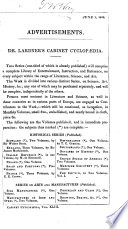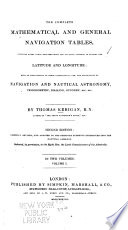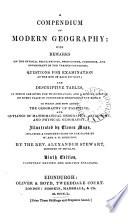 | John Robison - Astronomy - 1822 - 842 pages
...about the law of the solar force were founded on much easier observations. Kepler's third law is, that the squares of the periodic times of the planets are in the same proportion with the cubes of their mean distances from tJte Sun. Thus, Mars is nearly four times as far from the... | |
 | John Robison - Astronomy - 1822 - 860 pages
...the law of the solar force were founded on much easier observations. Kepler's third law is, that tJie squares of the periodic times of the planets are in the same proportion with the cubes oftlieir mean distances from the Sun. Thus, Mars is nearly four times as far from the... | |
 | sir John Frederick W. Herschel (1st bart.) - 1833 - 500 pages
...following proposition: — " The squares of the periodic times of any two planets are to each other, in the same proportion as the cubes of their mean distances from the sun." Take, for example, the earth and Mars*, whose periods are in the proportion of 3052564 to 6809796,... | |
 | Sir John Frederick William Herschel - Astronomy - 1838 - 444 pages
...following proposition:—" The squares of the periodic times of any two planets are to each other, in the same proportion as the cubes of their mean distances from the sun." Take, for example, the earth and Mars,* whose periods are in the proportion of 3652564 to 6869796,... | |
 | Thomas Kerigan - Nautical astronomy - 1838 - 804 pages
...body as their common centre of motion, the squares of their periodical times will be to each other in the same proportion as the cubes of their mean distances from the central body ; and hence the following rule :— As the square of the earth's periodical or annual... | |
 | Samuel Lytler Metcalfe - Heat - 1843 - 498 pages
...iii. Sect. 7.) strated that " the squares of the periodic times of any two planets are to each other, in the same proportion as the cubes of their mean distances from the sun,—a law which has been found equally true of satellites and their primaries,—if we except the... | |
 | Samuel Lytler Metcalfe - Heat - 1843 - 1198 pages
...iii. Sect. 7.) strated that " the squares of the periodic times of any two planets are to each other, in the same proportion as the cubes of their mean distances from the sun,—a law which has been found equally true of satellites and their primaries,—if we except the... | |
 | John Frederick William Herschel - Astronomy - 1849 - 672 pages
...following proposition:—" The squares of the periodic times of any two planets are to each other, in the same proportion as the cubes of their mean distances from the sun." Take, for example, the Earth and Mars,* whose periods are in the proportion of 3G52564 * The expression... | |
 | Hugo Reid - 1850 - 156 pages
...areas in equal times. 2. The orbits of the planets are ELLIPSES, having the sun in one of the foci. 3. The squares of the periodic times of the planets are...as the cubes of their mean distances from the sun. the former, but to follow the planet in its course round that orb, expanding or contracting according... | |
 | Alexander Stewart - 1850 - 480 pages
...areas in equal times. 2. The orbits of the planets are ELLIPSES, having the sun in one of the foci. 3. The squares of the periodic times of the planets are...as the cubes of their mean distances from the sun. The radius vector of a planet is an imaginary straight line from the sun to the planet, supposed to... | |
| |